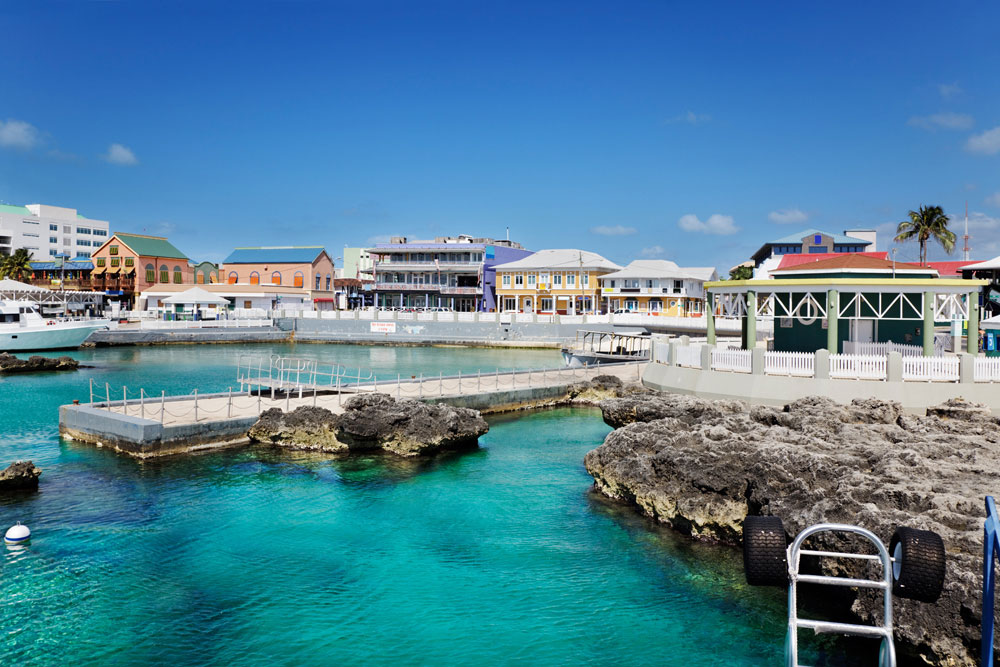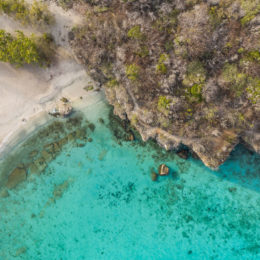Seven Miles to paradise . . .
Immediately north of George Town is the famous Seven Mile Beach, once voted the best in the Caribbean. Before you groan about the accuracy of the name — the beach is closer to five and a half miles long — consider the advantages of having this long stretch of coral sand right on your doorstep. With ample room for relaxing and adventure, this beach stretches along Grand Cayman’s western coast and is lined by the island’s most luxurious resorts, top restaurants, and tour companies.
The clear waters offshore are also perfect for divers and snorkellers to meet the residents of Cemetery Reef, which lies at the northern end of the beach. Despite its off-putting name, the reef is far from dead: rather, it’s one of the Caymans’ most beautiful diving spots, home to numerous species of coral, fish, and turtles.
. . . or highway to Hell?
In West Bay, a mere twenty minutes’ drive from George Town, you’ll encounter a garishly coloured sign enthusiastically offering a “WELCOME TO HELL.” Don’t worry, there’s neither fire nor brimstone. Instead you’ll find a labyrinth of black, jagged limestone formations, braided through with tiny streams of water, protruding from a lush, grassy field. This phytokarstic formation, as geologists describe it, is the result of erosion by limestone-eating algae boring into porous rock. Not quite a scene out of a horror movie, but it nonetheless captures the imagination of both locals and visitors with its striking contrast to the island’s otherwise idyllic countryside. At the nearby gift shop, painted bright red, you can buy a postcard from Hell to surprise your friends — or enemies? — back at home.
History
The Cayman Islands’ somewhat out-of-the-way location south of Cuba meant they were populated relatively late: no evidence has yet been found of an indigenous population, and though Columbus spotted the islands in 1503, it was the mid seventeenth century before British colonists settled permanently on the island of Grand Cayman.
Long governed from Jamaica, the Cayman Islands became a separate British colony in 1962, and its administrators focused on building an economy around tourism — capitalising on the fabulous beaches — and offshore banking. As a result, over the past four decades George Town has developed into a significant financial centre, with nearly six hundred banks and other financial services companies based in and around the city — though the skyline remains low-rise, and the balmy weather makes for a less stressful financial district than Wall Street in New York or the City of London.
Gardening in the tropics
Tucked away in the greenery of Grand Cayman’s North Side, away from the bustle of George Town, is an opportunity to wind down, enjoy the moment, and explore on your own beat. Opened in 1994 by Her Majesty herself, the Queen Elizabeth II Botanic Park is a sixty-five-acre oasis, featuring hundreds of plant species, a lake, and even the work of local artists. The park’s various trails and gardens are designed to tell the story of both the natural and human history of the Caymans, with a woodland area including more than half the known plant species of the islands, a Cayman Heritage Garden that explores the history of acriculture, and a special habitat area for the endangered endemic Blue Iguana, found only in Grand Cayman and once considered on the brink of extinction.
Drink deep
Almost every Caribbean territory distils rum — a legacy of the sugar industry — each with distinctive tweaks to the formula, but Grand Cayman’s Seven Fathoms Rum has a unique secret ingredient: the ocean. After being processed and casked in the distillery, the rum is sent offshore and submerged (you guessed it) seven fathoms deep for approximately three years. The ebb and flow of the sea’s rhythm, as well as the cool temperature, create optimal conditions for the aging and strengthening of its flavours. A tour at the Cayman Spirits Company distillery will fill you in on the story, and give you a chance to taste the uniquely smooth blend now exported around the world.
Art and identity
What does it mean to be a Caymanian? The National Gallery of the Cayman Islands in George Town, established in 1996, has more than one answer to that question, with its collection of works by dozens of Caymanian artists in all mediums, inspired by the islands’ landscape and history and a mandate to explore the links between the local art scene and the wider world. If you’re visiting in November or December, you’ll have the chance to take in a retrospective by Bendel Hydes, an elder figure in the Cayman art world and the first Caymanian artist to be internationally recognised. Visit nationalgallery.org.ky for more information.
Coordinates
19.3° N, 81.4° W
Sea level
Starting in December 2019, Caribbean Airlines will operate two return flights weekly to Owen Roberts International Airport in Grand Cayman from Kingston, with connections to other destinations in the Caribbean and North and South America






















